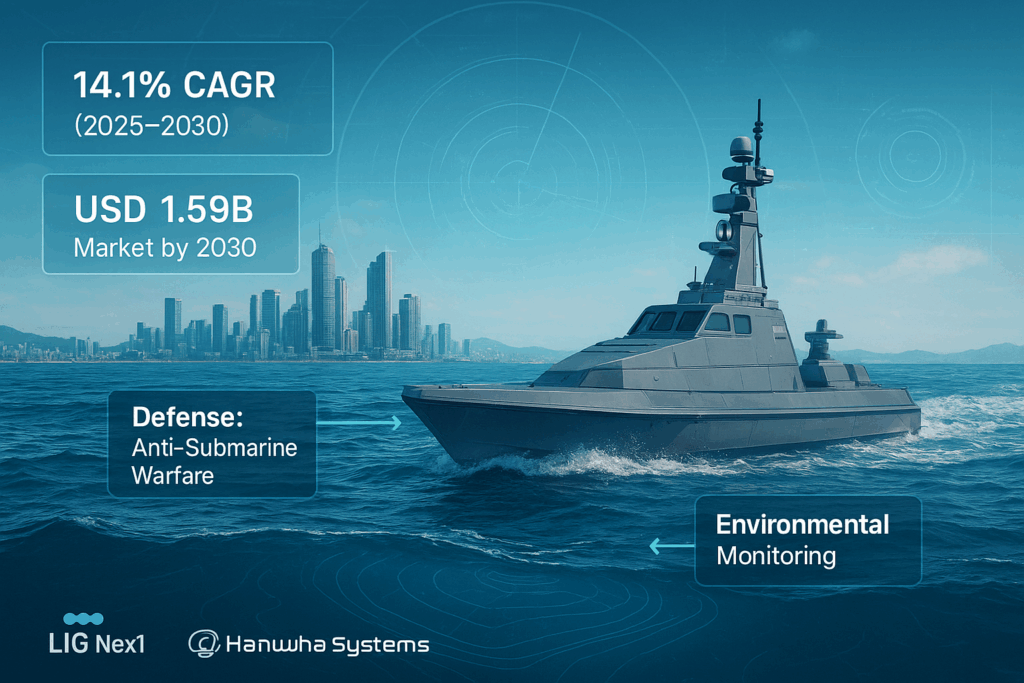At the forefront of this revolution is the Combat Unmanned Surface Vehicle (USV), a platform evolving at a breathtaking pace. Driven by a global USV market projected to grow from USD 0.82 billion in 2025 to USD 1.59 billion by 2030, the development of these vessels is guided by a simple, powerful mantra: they must become faster, smarter, and deadlier.

This isn’t just an upgrade; it’s a fundamental reimagining of maritime power projection. Let’s break down this evolution.
Download PDF Brochure @
https://www.marketsandmarkets.com/pdfdownloadNew.asp?id=220162588
1. FASTER: The Tactical Imperative of Velocity
The report highlights that the >30 knots segment is projected to lead the USV market. Speed is the new stealth, and for combat USVs, it is a non-negotiable asset for survival and effectiveness.
- Survivability: A slow-moving drone is a target. High speed (35-50+ knots) provides a critical defensive advantage, making it harder to hit and allowing for rapid disengagement after a mission.
- Rapid Response: Time is a weapon. Whether swarming an adversary’s vessel, responding to a submarine contact, or racing to intercept a fast-attack craft, speed allows a combat USV to dictate the terms of engagement and bring overwhelming force to a point of conflict before an enemy can react.
- Force Multiplication: A mothership can launch a squadron of high-speed USVs to patrol a vast area, creating a wide, responsive sensor and attack network without risking the capital ship.
2. SMARTER: The Rise of Autonomous Intelligence
Speed without brains is just directionless momentum. The “brain” of the modern combat USV is its autonomous suite, powered by artificial intelligence (AI) and machine learning (ML). This is where the true evolution lies.
- Collaborative Autonomy (Manned-Unmanned Teaming – MUM-T): The future is not a lone drone, but a networked “pack.” Combat USVs can now operate as a coordinated swarm, sharing data, distributing tasks, and overwhelming defenses with complex, synchronized maneuvers—all with minimal human intervention. They can act as forward sensor nodes for manned ships, painting a comprehensive picture of the battlespace.
- Advanced Decision-Making: AI enables beyond-line-of-sight operations and complex mission execution. From identifying and classifying threats using sensor fusion to making tactical decisions based on pre-defined rules of engagement, the USV is evolving from a remote-controlled toy into a true collaborative combatant.
- Adaptive Learning: Modern systems can learn from each mission, improving their ability to navigate challenging sea states, identify false targets, and optimize their tactics for future engagements.
3. DEADLIER: Integrated and Modular Lethality
The payload is the punch. The evolution here is away from single-purpose platforms towards modular, multi-mission vessels that can be rapidly reconfigured for a specific threat.
- Modular Payload Bays: A single USV hull can be equipped for:
- Anti-Submarine Warfare (ASW): Deploying towed array sonars and launching anti-submarine torpedoes.
- Anti-Surface Warfare (ASuW): Fitting with laser-guided rockets or missiles to engage surface targets.
- Electronic Warfare (EW): Jamming enemy communications and radar.
- Mine Countermeasures (MCM): Detecting and neutralizing naval mines.
- Weaponization: We are moving from intelligence, surveillance, and reconnaissance (ISR) platforms to directly armed systems. The integration of missile pods, directed energy weapons, and advanced gun systems transforms the USV from a scout into a lethal hunter.
Global Arms Race and Key Players
This evolution is fueling a global arms race. While established Western giants like L3Harris, Teledyne, and KONGSBERG lead in technology, other nations are making significant strides.
South Korea, with its advanced shipbuilding and tech sectors, is a key player to watch. Companies like LIG Nex1 and Hanwha Systems are developing sophisticated combat USVs designed for the specific challenges of the Asia-Pacific region. Their close integration with the Republic of Korea Navy ensures these systems are built for real-world, high-end combat scenarios, making them formidable competitors in the global market.
Ask for Sample Report @
https://www.marketsandmarkets.com/requestsampleNew.asp?id=220162588
Future Outlook
The evolution of the combat USV is not a niche project; it is the bedrock of future naval strategy. These faster, smarter, and deadlier systems offer a compelling combination: they enhance capability while reducing risk to human life and are more cost-effective than traditional manned platforms. As asymmetric threats grow and budgets are stretched, the demand for these advanced unmanned systems will only accelerate, permanently altering the balance of power on the world’s oceans.